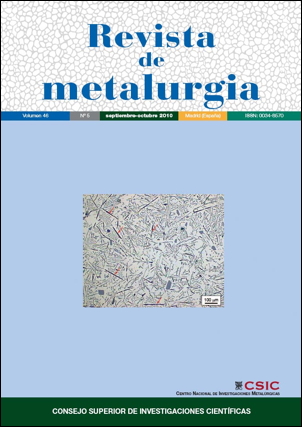Effect of die shape on the metal flow pattern during direct extrusion process
DOI:
https://doi.org/10.3989/revmetalm.0928Keywords:
Metal flow pattern, Flat die, Friction, Finite element, Equivalent strainAbstract
The geometric shape of the tools is the main factor by which an optimum technological process can be developed. In the case of extrusion process the strain distribution and other important variables that influence material structure, such as hydrostatic stress, are strongly dependent on the geometry of the die. Careful design of the extrusion die profile can therefore control the product structure and can be used to minimise the amount of inhomogeneity imparted into the product. A possibility to minimise the amount of product inhomogeneity is the using of a flat die with a fillet radius in front to the bearing surface with leads to a minimum dead zone and consequently to a minimum friction at billet-container interface. In the case of aluminium alloy type 2024, for an extrusion ratio of R=8.5, good results were obtained with a fillet radius of 3.0 mm. The experimental data have been used for the finite element numerical simulation of the extrusion process. The data obtained by numerical simulation with FORGE2 programme confirm the theoretical and experimental outcomes. The aim of this paper is to study the influence of such flat die on the material flow during direct extrusion process and consequently on extruded product microstructure and mechanical properties.
Downloads
References
[1] P.K. Bakshi and B.P. Kashyap, J. Mater. Sci. 30(1995) 5.295.
[2] G. Tempus, W. Calles and G. Scharf, Mater. Sci. Technol. 7 (1991) 937-945.
[3] A.K. Mukhopadhyay, H.M. Flower and T. Sheppard,Mater. Sci. Technol. 6 (1990) 611.
[4] T. Sheppard,Mater. Sci. Technol. 9 (1993) 430-440.
[5] G.E. Totten and D.S. MacKenzie, Handbook of Aluminum: Physical metallurgy and processes, Marcel Dekker (Ed.),New York, EE.UU., 2003.
[6] J. Kusiak, W. Libura, M. Pietrzyk and N. Solomon, Arch. Metall. 43 (1998) 4-14.
[7] W. Libura, Eng. Trans. 43 (1995) 245-257.
[8] W. Libura, J. Zasadzinski, J.Mater. Process. Tech. 34 (1992) 517. doi:10.1016/0924-0136(92)90149-M
[9] N. Solomon, PhD Thesis, University of Galati, 1997.
[10] N. Solomon,M. Teodorescu, I Solomon and F. Popescu, 15th Symp. ”Danubia-Adria” Bertinoro, Italy, 1998, p. 211.
[11] P. Kazanowski, H.M. Browneb, W. Libura and W.Z. Misiolek, Mat. Sci. Eng. A 404 (2005) 235-243. doi:10.1016/j.msea.2005.05.076
[12] M. Tokizawa and N. Takatsuji, Trans. Jpn. Inst. Met. 28 (1987) 994-1.003.
[13] M.P. Groover, Fundamentals of Modern Manufacturing:Materials, Processes, and Systems, 4th ed.,World Color, 2009.
[14] D.A. Smith, Die design handbook, Edition: 3 – Printed in US, 1990.
[15] W. Johnson, K. Kudo, The mechanics of metal extrusion, Manchester University Press, 1962.
[16] G. Spur, Th. Stöferle, handbuch der Fertigungstechnik, Band 2/2 Umformen, Carl Hanser Verlag München Wien, 1983.
[17] R.E. Sliwa, Proc. 6th ICTP, 1999.
[18] D.R. Askeland, P.P. Phulé, The science and engineering of materials, 5th ed., Cengage Learning, 2006.
[19] J.L. Chenot, J. Mat. Proc. Tech. 34 (1992) 9. doi:10.1016/0924-0136(92)90085-7
[20] T. Welo, S. Skjerrvold, O. Jensrud and K. Pedersen, J. Mat. Proc. Tech. 34 (1992) 533. doi:10.1016/0924-0136(92)90151-H
[21] J. G. Kaufman, Properties of aluminum alloys: tensile, creep, and fatigue data at high and low temperatures, The Aluminium Association, Inc., 1999.
[22] J.R. Davis & Associates, Aluminium and aluminium alloys, ASMHandbook series, Edition: 5, 1993.
[23] B.R. Tibbett and J. Ting-Yung, IEEE Trans. Cont. Syst. Tech. 6 (1998).
[24] J. Cao, N. Krishnan, Z.Wang, H. Lu,W. K. Liu and A. Swanson, Trans. ASME 126 (2004) 642-652. doi:10.1115/1.1773195
[25] P. Tiernan, M.T. Hillery, B. Draganescu and M. Gheorghe, J. Mat. Proc. Tech. 168 (2005) 360-366. doi:10.1016/j.jmatprotec.2005.02.249
[26] J. Maciejewski, H. Kope’c and H. Petryk, Eng. Trans. 55 (2007) 197-216.
[27] S. Li, M.A.M. Bourke, I.J. Beyerlein, D.J. Alexander and B. Clausen, Mat. Sci. Eng. A 382 (2004) 217-236. doi:10.1016/j.msea.2004.04.067
[28] M. Prakash and P. W. Cleary, CSIRO, Melbourne, Australia, 2006.
[29] S. Lou, G. Zhao, R.Wang and X.Wu, J.Mater. Process. Technol., 206 (2008) 481-490. doi:10.1016/j.jmatprotec.2007.12.084
Downloads
Published
How to Cite
Issue
Section
License
Copyright (c) 2010 Consejo Superior de Investigaciones Científicas (CSIC)

This work is licensed under a Creative Commons Attribution 4.0 International License.
© CSIC. Manuscripts published in both the printed and online versions of this Journal are the property of Consejo Superior de Investigaciones Científicas, and quoting this source is a requirement for any partial or full reproduction.
All contents of this electronic edition, except where otherwise noted, are distributed under a “Creative Commons Attribution 4.0 International” (CC BY 4.0) License. You may read the basic information and the legal text of the license. The indication of the CC BY 4.0 License must be expressly stated in this way when necessary.
Self-archiving in repositories, personal webpages or similar, of any version other than the published by the Editor, is not allowed.
















